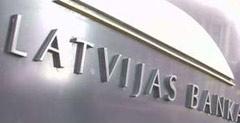Analytics, Financial Services, Latvia
International Internet Magazine. Baltic States news & analytics
Wednesday, 17.12.2025, 09:49
Bank of Latvia: current account's negative balance of payments continues to decrease
 Print version
Print version |
|---|
In the corresponding period of time last year, current account deficit of Latvia's balance of payments was LVL 837.7 million or 24.9% of the GDP, writes LETA.
LB points out that the country's economic activity in the second quarter decelerated sharply, with both the domestic and foreign demand weakening.
This notable decrease in the current account deficit was primarily on account of shrinking goods deficit to GDP (8.6%), with export growth sustained (13.1%) and imports losing 4%.
Slightly stronger surpluses of services and current transfers to GDP were recorded, with exports of services expanding more buoyantly and the volume of current transfers received by non-residents decreasing.
In the first half of 2008, the current account deficit accounted for 16.9% of GDP (25.6% of GDP in the corresponding period of the previous year).
Four-fifths of the second quarter current account deficit was covered by long-term capital. Of the latter, 58% was foreign direct investment. Other investment net inflow was LVL 446.1 million, whereas reserve assets increased by LVL 49.6 million.
Gravitis explains that in the second quarter of 2008, the economic growth in Latvia continued to slow down, and, in line with expectations, the current account deficit of Latvia's balance of payments decreased notably, thus easing the risks of non balanced development.
As a result of modest foreign capital inflows and decelerating pace of lending together with slower real income growth and low consumer and producer confidence indicators, the domestic demand was weak, triggering a sharp decline in imports and diminishing the demand pressure on inflation.
"Although in the second quarter the decrease in the volume of imports reached a double-digit level, the hikes in mineral product and metal prices had a strong effect and ruled out a more significant improvement of the trade balance," Gravitis explained.
Notwithstanding a slightly weakened demand in Latvia's major trade partner countries and rises in domestic costs, exports continued to expand. This tendency suggests that Latvian producers have retained their competitiveness in major export markets, yet slow expansion of export volumes and recently experienced deceleration in export growth dynamics give signals of deterioration in exporters' ability to compete.
As of positive developments, long-term capital retained its significance in financing the current account deficit and bank short-term foreign borrowings were refinanced with long-term capital (the latter spurred by the Bank of Latvia reducing the reserve ratio for bank liabilities with maturity of over two years).
"The weak domestic demand would underpin a decrease in the current account deficit in the future as well. However, the impact of the global financial market turmoil on the growth in Latvia's major trade partner countries suggests upward risks for the future export growth," Gravitis underlined.
"On this background, the role of the government's fiscal policy increases. A balanced budget for 2009 would assist consolidation of the declining inflation trend ongoing since the second half of the year and would further reduce the excess of imports over exports," Gravitis said. At the same time, weakening foreign demand and tightening international competition call for an immediate introduction of export promoting measures."








 «The Baltic Course» Is Sold and Stays in Business!
«The Baltic Course» Is Sold and Stays in Business!

